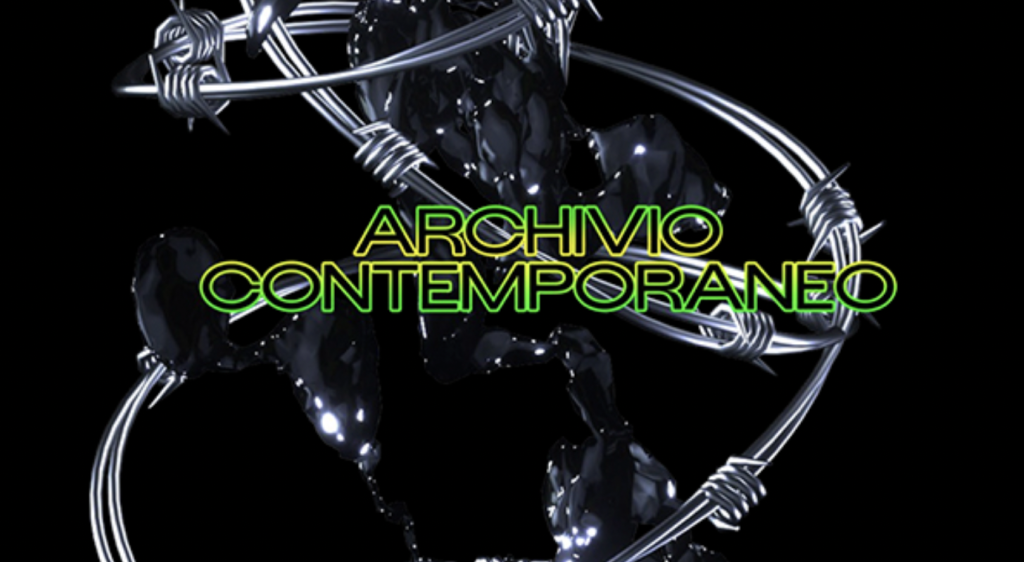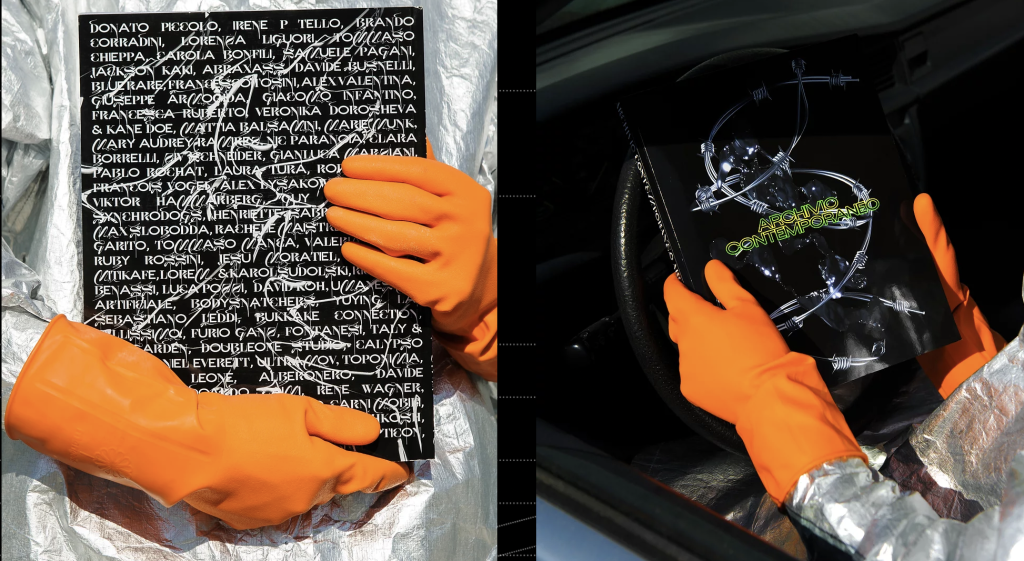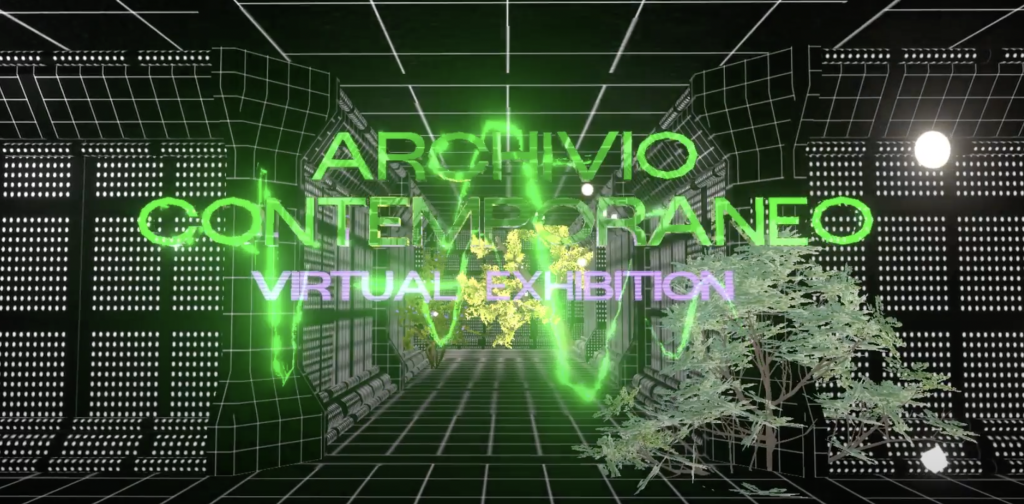Text by Visioni Parallele

Archivio Contemporaneo is a limited edition paper and multimedia catalogue, conceived and produced by Visioni Parallele Creative Studio. The main aim behind the project is to define alternative narrative paths and present a selection of the most experimental and interesting artistic experiences of contemporary creativity: a collective of ideas that coexist in parallel through visual and multimedia content, told through a hybrid product, straddling the paper and digital worlds. Archivio Contemporaneo is the construction of a further history, an impossible and antithetical cataloguing aimed at investigating the relationships between the visual arts.
We like to define Archivio Contemporaneo as a collective of ideas that coexist in parallel through
visual and multimedia content, a visual and conceptual laboratory in which we can above
all experiment, activate critical thinking and elaborate new visions and perspectives of reality.
The subject of archives is connected to numerous aspects of the visual, social, political and cultural environment we live in, and, in many ways, it’s deeply contradictory. For Archivio Contemporaneo, this argument was a medium through which to choose and collect something but, above all, to rethink and narrate. From the outset, temporality was a pivotal point on which to structure the entire reflection.
Archivio Contemporaneo exists in the present. This temporality precisely places it in an indefinite, elusive space where the classification of research is not linked to any sedimentation process, moving totally away from the concept of recovery and memory. As it has no parameters or temporal margins, Archivio Contemporaneo is constantly incomplete. It is far from being a place of physical deposit and instead close to a process laboratory, at times random and imperfect, where to assemble and destroy.
In the first issue, different places and languages have been put into relation to define landscapes in which the common space-time boundaries change, defining six different imaginaries populated by more than seventy international artists: MetaSpace, Umano non-umano, Unreal is the new real, Third Self, The mixed reality, Crudo, Matters still matters.
Each one of the scenarios represents the artistic research carried out by the selected authors: readers and professional critics of the contemporary scene, visionaries who are able to interpret the reality that surrounds them, keen observers of the context we are living in and fully aware of the power of observation as a possible legacy. Each theme ends up being perfectly suited to the words of the protagonists, for they emerge from their capacities as well as their shared view of reality. Following are some excerpts of these seven imaginaries:
Metaspace by Donato Piccolo: The knowledge of the universe is very little; we shall imagine its composition to be 5% matter, yet we know nothing of the remaining 95%; we only assume it exists. Bearing in mind that space itself is a MetaSpace, it remains invisible as the dark side of the universe, the hidden face of nature. Space is, by definition, the vacuum that exists between two celestial bodies; Physics, however, does not interpret the ‘vacuum’ as such: it is full and composed of low-density particles. Similarly, in art, the void is the element that connects us to another dimension. We speak of an “other” dimension that allows us to rise above our terrestrial condition towards what we might refer to as Metaspace.
Umano, non-umano by Giuseppe Armogida: In other words, art can force systems of knowledge to take leaps of thought that fill the gaps between what is possible (what is already established in advance) and what is potential (what is still unthinkable, but nevertheless plausible) with unexpected forces and powers that alter paradigms and trajectories. Classification then shifts from the human and arboreal hierarchical models of domination to classification through infinite connectivity, resulting from multiple rhizomatic interactions and minority recombinations. This is possible because the artistic device deals with the untranslatable and, therefore, is able to “touch” that point of extimacy where existence ends and clairvoyance begins.
Unreal is the new real by Gianluca Marziani: Philosophers work on the new bridges with technology (Lovelock), biology (Haraway), climate (Latour), and relational forms (Bourriaud); Gibson offers sociological suggestions through dystopian fiction, whereas a visionary entrepreneur, namely Elon Musk, connects the theoretical lines to “terraform” a habitable model for the future. In general, the artist of Novacene challenges the solid reality of the past century and creates visions where space is palpable and in efflux. It is similar to a hexagon in the circular efflux, in a cosmic archipelago with no polarized ideologies. A place where semantic buoyancy unravels the real potential of our brains. No doubt: unreal is the new real.
Third self by Emilia Garito: The dimension of our identity grows and feeds off means of expression which are bringing us closer to the physical world, which is, on the one hand, constraining us, on the other, opening our eyes to a new definition of closeness and empathy: the one that Artificial Intelligences imagine for us. Thanks to our multidimensionality, in which physics intersects with biology to create a new experiential model, we live the present as a mirror of the future, a future that is too far for us to possess but which our third self is already programmed to encode as a unique opportunity for human progress.
The mixed reality by David Koh: Who is the third persona? It is not I, nor is it you – it is another entity altogether, a combination of our reflections. As our world advances into a hyperreality full of half-truths and partial fictions, we are confronted with the third persona. Existing in the liminal space between physical and digital, we must now reckon with converging worlds and the possibility that our perspectives are not our own. Mixed reality gives us the possibility to view this convergence first-hand and makes us question, who am I when you are I?
Crudo by Sebastiano Leddi: Even now, we are used to smiling when put in front of a camera; it is a legacy connected to the advertising culture: Cheese… I believe this narrative to be outdated. First, the internet and then social media have caused a profound change; in this sense, the authors present in Crudo are representative of some of the sons of this revolution. If it was not beauty but ugliness, mistake, or inaccuracies to distinguish this scenario? Someone may think so; the theme is definitely broad, as well as controversial.
Matters still matters by Cristiano Leone: The phrase “Less is more”, coined by Ludwig Mies van der Rohe, has long been the drive to the constant subtraction of content. On the other hand, contemporary art has moved on to “More is different” – quoting Nobel Prizewinning physicist Phil Anderson, to prove that the more one penetrates matter, the more it turns out to be rather different to what we usually experience. Hence, a new way of exploring matter opens up to the artists of today, not forgetting that everything is matter, even antimatter. The digital is matter too. Maybe, the artist’s role – as it was for Paul Klee – is that of making the invisible visible. A bit of Matter and a little bit More.


The research and selection phase was completely free of conceptual constraints; following this phase, all searches were analysed until the cataloguing skeleton that today defines Archivio Contemporaneo was structured. These words must be imagined as perimeters of thought, action and form, in which research can be identified and questioned thanks to its organic and overall vision.
The magazine is part of wider research carried out in recent years by Visioni Parallele Creative Studio, in which the crisis and connection of the material and digital world have always represented a process of analysis necessary for producing new content.
These two aspects have been constitutive also in every phase of Archivio Contemporaneo’s creation. The archive is an extremely dynamic and mutable device relative to the moment in which it is created and consulted; it is no coincidence that Archivio Contemporaneo. was initially born from a selection of projects identified and proposed on Instagram and that only later were they formalized in a paper product.
Social networks, and more generally, the Internet, represent an open virtual system and research resources. Still, also a fragmented and elusive space, and perhaps this is where the need to stop and collect comes from.
Lastly, in this first publication, a virtual proposal of the magazine has been realized: those who will buy it will be able to see an exclusive Virtual Exhibition created by the Japanese artist Jackson Kaki and the possibility to enjoy some works in augmented reality, a work developed by Umanesimo Artificiale collective.






